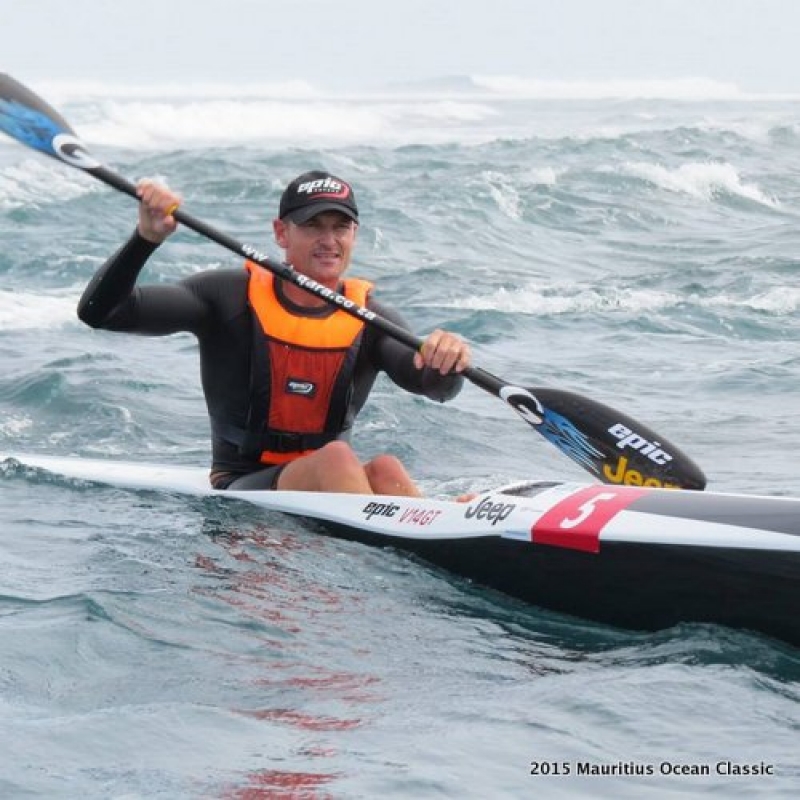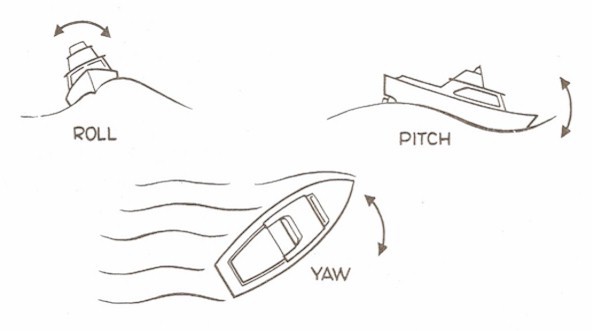Relax – a few extra pounds may be a good thing. In your surfski.
 Hank McGregor - on the ultra-light 8.9kg/20lb V14 GT.
Hank McGregor - on the ultra-light 8.9kg/20lb V14 GT.
There’s just nothing like the feel of taking your feather-weight 24lb (11kg) surfski off your car racks with one hand, carrying it to the water with one hand, and with one hand setting it down gently onto the H2O while all about you other paddlers are lugging kayaks apparently constructed of depleted uranium. Until you get into your boat and paddle it into some rougher water.
Ultra-light; Ultra-reactive
Then you notice your ultra-light boat is also ultra-reactive, reaching up and threatening to toss you into the drink every time you make an error. Now this can be a lot of fun if you have the skill to handle the boat. But what if you’re just not quite there, the waves are kicking up, and the wind’s blowing a bit? Do you need to humble yourself and drop back one level in your ski? Not necessarily. At least if you don’t mind using a little extra on-shore muscle. And keep in mind that even “heavy” surf skis at 34 lbs or so are still exceptionally light in the world of kayaks.
Among the surf ski community, the common mantra seems to be: buy the lightest boat you can afford! But that may not always a good idea. Arguments have been made that the lightest ski is the fastest ski – and that’s essentially true, all else being equal. Unfortunately, all else is not equal. If we all had equally good balance in all skis and all conditions, we could “buy” time reductions in our races by simply buying lighter boats, and certainly the elite-level racers typically go for the lightest, fastest skis available. Now for the rest of us – those who have families, hold down jobs, don’t live on a bay, and find ourselves aging a bit – we generally don’t have the time or opportunity to train to perfection. But we can “tune” things a bit in our favor.
One overlooked aspect of surf ski weight is balance. The distributed mass of a surf ski (the boat weight due to the layup, rather than people/gear/etc. on board) significantly affects the stability of the boat, and unless you’re reasonably stable in your ski, you won’t be as fast as you could be. Right at the start of a race, when you could be really launching that light boat, if your stability is lacking you’ll be paddling tepidly until you get moving, while all about you the water is frothing with the wakes of those who launched right past you. Even if you’re moving along on flat water and generally feeling comfortable, when beam chop kicks up or a motorboat comes hauling past you, if your stability goes out the window in those waves you’ll suddenly find your stroke falling apart and you’ll be bracing when you should be hammering the water.
Not ideal for good race times. Even if you’re just playing on the waves in big water, if you don’t have the stability to paddle aggressively enough to get on a wave or if you fall apart when some cross-chop comes into play, it won’t be nearly as fun as it could be. But don’t lose heart. Saving money – by going with a less expensive, heavier layup - may actually improve your paddling!
The Theory
As you paddle your boat, you’re generally dealing with 4-degrees of freedom: 1 translational degree (forward motion) and 3 rotational degrees (pitch, roll, and yaw). In waves there will also be some vertical translation and some lateral translation, but we can ignore those directions for purposes of this discussion. We’ll also ignore forward motion for the most part and focus on the three degrees of rotation. Think of three axes running through you and your boat: a longitudinal axis runs end-to-end in the boat; the boat rolls around this axis from beam waves, rocking you side to side.
Another could be thought of as running perpendicular to the longitudinal axis and basically going through your rear end out either side of the boat and parallel to the water. This is your pitch axis; the boat pitches up and down at the front and rear from going into or being passed through by waves. The third axis could be thought of as running straight down through your head and back and out the top and bottom of the boat. This is your yaw axis; angled waves, eddies, etc. will catch either the nose or tail of the boat and cause the front and back to yaw side to side. It really gets fun when water conditions cause your boat to pitch, roll, and yaw all at the same time!
For the purposes of looking at this mathematically, we could consider the boat to act as a pendulum in each direction, with the pivot point being the intersection of the axes (basically where your bottom sits). For some good images of pitch, roll, and yaw in a boat, see http://www.boatsafe.com/nauticalknowhow/captpat1.htm
I also like the image below, taken from http://kayakingdog.com/

It’s all about the Math
The Rotational Inertia of a body (how easily something can be made to rotate) defines the torque (the force to make it rotate) needed for a given angular acceleration (how quickly something is rotated) of a body around an axis. Just like the way an ice skater can speed up or slow down their rotation in a spin by extending their arms or bringing them in, so also changing the mass in a boat or the distribution of the mass about an axis of rotation (like making the ends heavier) alters the rotational quickness of the boat.
Simplifying things a bit, a little more mass distributed throughout a surf ski can slow down the reactivity of the boat to the forces that want to pitch, roll, and yaw the boat, thereby increasing the “stability” of the boat. As a rule of thumb, our lightest skis tend to be around 24 - 26 lbs; the next step up in weight (and down in cost) typically results in a boat of around 32 - 34 lbs, or roughly 1/3 heavier.
Using the simplified formulas of I=mr2, with I = rotational inertia, m=mass, and r=radius (distance from pivot point), and τ=Iα, with τ=applied torque, I= rotational inertia, and α=angular acceleration, you can combine the two formulas to show that angular acceleration (how quickly the boat reacts in a given axis) is proportional to the inverse of mass (assuming r and τ remain constant, because in the same boat model r will be the same, and we’ll assume τ is constant for each layup and comes from the forces of the waves against the boat); i.e. α= τ/(mr2), with τ and r constant between boats, the α is proportional to 1/m.
So now our 1/3rd heavier boat should theoretically cut the rotational acceleration of the boat by roughly 1/3! With the rotational acceleration of the boat reduced (pitch, roll, and yaw rates slowed down), it’s easier for our bodies to react to the (now slower) changes in boat angle, and thus the boat will feel more stable.
Experience: Weight and See
The mathematics are borne out in real-life observations by a number of paddlers. A few years back, my wife was paddling a fiberglass Think Fit – pretty much the first “cross-over” boat, combining sea kayak dimensions with a surf ski cockpit. She was comfortably stable in the boat, but thought she would like the lighter Kevlar version in case she wanted to take it somewhere herself. At one USCA Nationals race she had the opportunity to try out a Kevlar version of the Think Fit another paddler brought to the race. After trying it out, she changed her mind about wanting one, saying she felt a lot less stable in it.
That really surprised me, and I assumed at the time it was probably just how she was feeling that day.
Now I realize the lighter layup moved the stability of the boat out of her comfort zone. A couple of years later I owned a carbon Stellar SE surf ski, enjoying the light weight of the boat and feeling quite comfortable with it on flat water, but when the waves picked up I found myself “stability challenged”. I got to where I could handle some decent waves reasonably well, but I never felt fully comfortable in those waves. Yet, when I went to Traverse Bay one time and borrowed an SEL in the heavier Advantage layup, I charged out into the bay and played for hours in the waves, having a blast and feeling very confident the whole time. I kept wondering at the time “Did they change the hull design between these two?”
Assuming the hull design was different (even though it was advertised as the same), I almost ordered a carbon SEL. In the back of my mind I wondered if the heavier layup had made the difference, but it was hard for me to believe it was that dramatic. About two years ago I picked up my Epic V12, fabricated in the heavier performance layup. I was delighted with the way the boat paddled; it felt quite stable to me (more stable than the Epic V10 Ultra I owned previously), which really surprised me since I heard from several owners that the V12 felt “nervous” and “twitchy”.
Looking back, all of those owners had Ultra or carbon layups. Something was coming together here… More recently I had the opportunity to try out a number of boats at a Stellar dealer conference, including an SEL in Advantage Layup (heavier) and an SEL in Excel Layup (lighter). Trying out those boats back-to-back confirmed what I had been wondering since my Traverse Bay encounter: the heavier boat was definitely more stable. I was comfortable in the Excel layup, but completely relaxed in the Advantage layup. It felt like a solid intermediate ski, but with the speed of the elite ski that it is. Interestingly, another dealer & paddle racer commented in the meeting after we returned (without any discussion between us) that he thought the SEL (an elite-level boat) in the Advantage layup was just as stable as the SEI (an intermediate-level boat) in the Excel layup. As the owner of an SEI in Excel, I wholeheartedly concur. I think it’s even more stable.
Bringin’ it home
So what does all this mean practically? As I see it, depending on what’s most important to you, it’s possible to tune your boat to fit your needs. If you’re racing and you want fast flat-water speed, but you’re still developing stability skills, you may be able to move up a step in boat class by going with a heavier layup in a longer, narrower boat. You’ll gain more from the more efficient hydrodynamic shape of the hull than you will from a lighter but shorter/wider hull.
If light weight and easy off-water handling is important, while all-out speed is less so, you may be able to move down one class and go with a lighter layup to keep the same stability. As for speed: sufficient stability to employ a fully-powered stroke is more important than having the lowest-resistance hull when it comes to obtaining YOUR highest speed on the water. A lighter hull may be worth a few to several seconds in an hour race, assuming you have the stability to handle it. If you don’t, you may actually lose time because you’ll be bracing or paddling tepidly when conditions degenerate – and they always do.
As with most things in life, balance is the key. In more ways than one.

